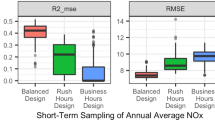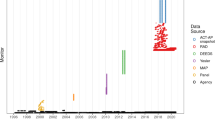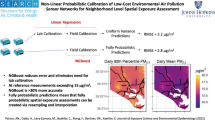Abstract
Sampling campaign design is a crucial aspect of air pollution exposure studies. Selection of both monitor numbers and locations is important for maximizing measured information, while minimizing bias and costs. We developed a two-stage geostatistical-based method using pilot NO2 samples from Lanzhou, China with the goal of improving sample design decision-making, including monitor numbers and spatial pattern. In the first step, we evaluate how additional monitors change prediction precision through minimized kriging variance. This was assessed in a Monte Carlo fashion by adding up to 50 new monitors to our existing sites with assigned concentrations based on conditionally simulated NO2 surfaces. After identifying a number of additional sample sites, a second step evaluates their potential placement using a similar Monte Carlo scheme. Evaluations are based on prediction precision and accuracy. Costs are also considered in the analysis. It was determined that adding 28-locations to the existing Lanzhou NO2 sampling campaign captured 73.5% of the total kriged variance improvement and resulted in predictions that were on average within 10.9 μg/m3 of measured values, while using 56% of the potential budget. Additional monitor sites improved kriging variance in a nonlinear fashion. This method development allows for informed sampling design by quantifying prediction improvement (accuracy and precision) against the costs of monitor deployment.
This is a preview of subscription content, access via your institution
Access options
Subscribe to this journal
Receive 6 print issues and online access
$259.00 per year
only $43.17 per issue
Buy this article
- Purchase on Springer Link
- Instant access to full article PDF
Prices may be subject to local taxes which are calculated during checkout






Similar content being viewed by others
References
Spira-Cohen A, Chen LC, Kendall M, Lall R, Thurston GD. Personal exposures to traffic-related air pollution and acute respiratory health among bronx school children with asthma. Environ Health Perspect. 2011;119:559–65.
Steinle S, Reis S, Sabel CE, Semple S, Twigg MM, Braban CF. et al. Personal exposure monitoring of PM2.5 in indoor and outdoor microenvironments. Sci Total Environ. 2015;508:383–94.
Brus DJ, Heuvelink GBM. Optimization of sample patterns for universal kriging of environmental variables. Geoderma. 2007;138:86–95.
Berman JD, Breysse PN, White RH, Waugh DW, Curriero FC. Evaluating methods for spatial mapping: applications for estimating ozone concentrations across the contiguous United States. Environ Technol Innov. 2015;3:1–10.
Mercer LD, Szpiro AA, Sheppard L, Lindström J, Adar SD, Allen RW. et al. Comparing universal kriging and land-use regression for predicting concentrations of gaseous oxides of nitrogen (NOx) for the multi-ethnic study of atherosclerosis and air pollution (MESA Air). Atmos Environ. 2011;45:4412–20.
Novotny EV, Bechle MJ, Millet DB, Marshall JD. National satellite-based land-use regression: NO2 in the United States. Env Sci Technol. 2011;45:4407–14.
Beelen R, Hoek G, Pebesma E, Vienneau D, de Hoogh K, Briggs DJ. Mapping of background air pollution at a fine spatial scale across the European Union. Sci Total Environ. 2009;407:1852–67.
Lee A, Szpiro A, Kim Sy, Sheppard L. Impact of preferential sampling on exposure prediction and health effect inference in the context of air pollution epidemiology. Environmetrics. 2015;26:255–67.
Gryparis A, Paciorek CJ, Zeka A, Schwartz J, Coull BA. Measurement error caused by spatial misalignment in environmental epidemiology. Biostatistics. 2009;10:258–74.
Matte TD, Ross Z, Kheirbek I, Eisl H, Johnson S, Gorczynski JE. et al. Monitoring intraurban spatial patterns of multiple combustion air pollutants in New York City: design and implementation. J Expo Sci Environ Epidemiol. 2013;23:223–31.
Szpiro AA, Sampson PD, Sheppard L, Lumley T, Adar SD, Kaufman JD. Predicting intraurban variation in air pollution concentrations with complex spatio-temporal dependencies. Environmetrics. 2010;21:606–31.
Jerrett M, Arain MA, Kanaroglou P, Beckerman B, Crouse D, Gilbert NL. et al. Modeling the intraurban variability of ambient traffic pollution in Toronto, Canada. J Toxicol Environ Health Part Curr Issues. 2007;70:200.
Diggle PJ, Menezes R, Su T. Geostatistical inference under preferential sampling. J R Stat Soc Ser C Appl Stat. 2010;59:191–232.
Gelfand AE, Sahu SK, Holland DM. On the effect of preferential sampling in spatial prediction. Environmetrics. 2012;23:565–78.
Kumar N, Nixon V, Sinha K, Jiang X, Ziegenhorn S, Peters T. An optimal spatial configuration of sample sites for air pollution monitoring. J Air Waste Manag Assoc. 2009;59:1308–16.
Su JG, Larson T, Baribeau A-M, Brauer M, Rensing M, Buzzelli M. Spatial modeling for air pollution monitoring network design: example of residential woodsmoke. J Air Waste Manag Assoc. 2007;57:893–900.
Kanaroglou PS, Jerrett M, Morrison J, Beckerman B, Arain MA, Gilbert NL. et al. Establishing an air pollution monitoring network for intraurban population exposure assessment: a location–allocation approach. Atmos Environ. 2005;39:2399–409.
Romary T, de Fouquet C, Malherbe L. Sampling design for air quality measurement surveys: an optimization approach. Atmos Environ. 2011;45:3613–20.
Nitrogen Oxides Diffusion Tubes. Environmental Monitoring Products. Ormantine USA, Ltd. http://www.ormantineusa.com/nitrogen-oxides-diffusion-tubes Accessed Jan 13, 2017.
Ebisu K, Holford TR, Belanger KD, Leaderer BP, Bell ML. Urban land-use and respiratory symptoms in infants. Environ Res. 2011;111:677–84.
Adamkiewicz G, Hsu H-H, Vallarino J, Melly SJ, Spengler JD, Levy JI. Nitrogen dioxide concentrations in neighborhoods adjacent to a commercial airport: a land-use regression modeling study. Environ Health. 2010;9:73.
Ross Z, English PB, Scalf R, Gunier R, Smorodinsky S, Wall S. et al. Nitrogen dioxide prediction in Southern California using land-use regression modeling: potential for environmental health analyses. J Expo Sci Environ Epidemiol. 2005;16:106–14.
Young MT, Bechle MJ, Sampson PD, Szpiro AA, Marshall JD, Sheppard L. et al. Satellite-based NO2 and model validation in a national prediction model based on universal kriging and land-use regression. Environ Sci Technol. 2016;50:3686–94.
Bostan PA, Heuvelink GBM, Akyurek SZ. Comparison of regression and kriging techniques for mapping the average annual precipitation of Turkey. Int J Appl Earth Obs Geoinf. 2012;19:115–26.
Cressie, NAC Statistics for Spatial Data. J. Wiley; 1993.
Diggle PJ. Model‐based geostatistics. J R Stat Soc Ser C Appl Stat. 1998;47:299.
Bivand, RS; Pebesma, EJ; Gómez-Rubio, V. Applied Spatial Data Analysis with R. Springer; 2008.
Curran PJ, Atkinson PM. Geostatistics and remote sensing. Prog Phys Geogr. 1998;22:61–78.
Gotway CA. The use of conditional simulation in nuclear-waste-site performance assessment. Technometrics. 1994;36:129–41.
Gaffney SH, Curriero FC, Strickland PT, Glass GE, Helzlsouer KJ, Breysse PN. Influence of geographic location in modeling blood pesticide levels in a community surrounding a U.S. Environmental protection agency superfund site. Environ Health Perspect. 2005;113:1712–6.
Pebesma EJ. Multivariable geostatistics in S: The Gstat Package. Comput Geosci. 2004;30:683
Cambardella CA, Moorman TB, Parkin TB, Karlen DL, Novak JM, Turco RF. et al. Field-scale variability of soil properties in Central Iowa Soils. Soil Sci Soc Am J. 1994;58:1501–11.
Sampson PD, Richards M, Szpiro AA, Bergen S, Sheppard L, Larson TV. et al. A regionalized national universal kriging model using partial least squares regression for estimating annual PM2.5 concentrations in epidemiology. Atmos Environ. 2013;75:383–92.
Grisotto L, Consonni D, Cecconi L, Catelan D, Lagazio C, Bertazzi PA. et al. Geostatistical integration and uncertainty in pollutant concentration surface under preferential sampling. Geospatial Health. 2016;11:56–61.
Delfino RJ, Wu J, Tjoa T, Gullesserian SK, Nickerson B, Gillen DL. Asthma Morbidity and Ambient Air Pollution: Effect Modification by Residential Traffic-Related Air Pollution. Epidemiology 2014; 25:48–57.
Gurung A, Levy JI, Bell ML. Modeling the intraurban variation in nitrogen dioxide in urban areas in Kathmandu Valley, Nepal. Environ Res. 2017;155:42–48.
Van Groenigen JW. The influence of variogram parameters on optimal sampling schemes for mapping by kriging. Geoderma. 2000;97:223–36.
Acknowledgments
We acknowledge Qiusheng Jin, Bei Zhang, and Yaqun Zhang for assistance in the field work. L. Jin was supported by a Yale Hixon Center for Urban Ecology Research Fellowship, a Yale Tropical Resources Institute Endowment Fellowship, Yale Global Health Initiative Field Experience Award, and a Yale Graduate School John F Enders Fellowship. This article was developed under Assistance Agreement No. RD835871 awarded by the U.S. Environmental Protection Agency to Yale University. It has not been formally reviewed by EPA. The views expressed in this document are solely those of the authors and do not necessarily reflect those of the Agency. EPA does not endorse any products or commercial services mentioned in this publication.
Funding
L. Jin was supported by a Yale Hixon Center for Urban Ecology Research Fellowship, a Yale Tropical Resources Institute Endowment Fellowship, Yale Global Health Initiative Field Experience Award, and a Yale Graduate School John F. Enders Fellowship. This article was developed under Assistance Agreement No. RD835871 awarded by the U.S. Environmental Protection Agency to Yale University. It has not been formally reviewed by EPA. The views expressed in this document are solely those of the authors and do not necessarily reflect those of the Agency. EPA does not endorse any products or commercial services mentioned in this publication.
Author information
Authors and Affiliations
Corresponding author
Ethics declarations
Conflict of interest
The authors declare that they have no conflict of interest.
Electronic supplementary material
Rights and permissions
About this article
Cite this article
Berman, J.D., Jin, L., Bell, M.L. et al. Developing a geostatistical simulation method to inform the quantity and placement of new monitors for a follow-up air sampling campaign. J Expo Sci Environ Epidemiol 29, 248–257 (2019). https://doi.org/10.1038/s41370-018-0073-6
Received:
Revised:
Accepted:
Published:
Issue Date:
DOI: https://doi.org/10.1038/s41370-018-0073-6



